Tag Archives: 2017
So Many Reflections I’m Basically Mulan
After spending two weeks in Belize immersed in coral reef and tropical rainforest environments, I’ve gotten much deeper insight into these two ecosystems which have always fascinated me. I was surprised to learn that such biologically diverse ecosystems exist in nutrient-poor conditions. I always imagined that there would need to be a nutrient-rich foundation to sustain the plethora of organisms that live within each ecosystem, but that’s not the case – actually, for the coral reef it can be quite harmful. The stony corals that form the reef thrive in nutrient-poor environments and, as Ellie told us, if too many nutrients enter the system, the reef will undergo a phase shift which means that it will become overrun by algae. In the case of the rainforest, Sarah T. gave us the lowdown about how there is only a very thin layer of soil (the topsoil) which contains most of the available nutrients. The low levels of nutrients are caused in part by rapid nutrient recycling; as nutrients become available, they are quickly used by the many organisms that inhabit the two ecosystems.
Another similarity I noticed between the two ecosystems is how many symbiotic relationships there are. This is likely because the high species density in coral reefs and rainforests brings many organisms into close proximity, resulting in more specialized niches. An example in coral reefs that Sarah G. talked about is the mutualistic relationship between dinoflagellates and corals. The dinoflagellate provides photosynthetic products to the coral, while the coral provides shelter to the dinoflagellates. In the rainforest, a symbiotic relationship Scott and I discussed is when leafcutter ants cultivate fungus gardens. The fungus breaks down the leaves that the ants can’t digest, producing nutritious swellings called gongylidia. In return, the fungus receives shelter and protection.
Ultimately, the two ecosystems are more alike than I realized at first sight. Even though I had been to both a rainforest and coral reef before this course, I had never really connected the dots between the two. I had always separated them in my mind due to the obvious difference that one ecosystem is on land and the other is underwater. It was really interesting to look at them comparatively. Although there are some differences like coral reefs being more sensitive and susceptible to changing environmental factors when compared to rainforests, it’s become obvious to me now how much more they have in common.
This course went above and beyond my expectations which were to learn about field work and to look at coral reefs and rainforests through a more scientific lens than I had while on vacation. While I did come away with a greater knowledge of the ecosystems and a better understanding of being a field biologist, I also created friendships and had the most fun I’ve had in a while. I feel extremely lucky to have been part of such an amazing group. It was so interesting to watch everyone become comfortable with each other to the point where it became non-stop laughing and joking around. That was definitely the best part of the trip for me. Honestly, the only downside I can think of is that the weather didn’t permit for a night dive. With all the snorkeling and scuba diving I’ve done, I have never gone in the water at night which I thought that would be neat, but oh well.
I’ll definitely hold on to a lot of the things I’ve learned throughout the course, especially the experiential learning aspects of how science is done out in the field. It was fascinating to consider how many different directions a project can take, and how one observation can spark years of research. It’s kind of like how Therese’s work on defaunation in Gabon lead to her new project on seed-dispersal in Peru. I’ll also remember how important it is to talk to other people about their work. Scott and Adrienne really encouraged us to take advantage of where we were and to talk to the researchers at the stations. I’m normally not one to approach people I don’t know, but I made it a point to go out of my way to talk to the researchers at Glover’s and the archeology team at Las Cuevas. I’m glad I did because I got so much out of hearing their stories and listening to what they were working on. Lastly, I was completely surprised with how awesome ants are. To be honest, I wasn’t thrilled that I got ants as my taxon but I was quickly converted. I always thought it odd that my grandmother never killed the ants that crawled along the windowsills in her house, but now I understand. This trip ruined me – I’ll never be able to squish an ant again.
Until next time, Belize. Hopefully I’ll be back soon to dive the Blue Hole and swim with whale sharks. Sorry Scott, Team Surf for life.
A Budget for Bulging Bellies and a Goodbye to Belize
5.30.2017
Today began much like any other day, except instead of leaving Las Cuevas on foot to hike through the Chiquibul rainforest, a van pulled up to drive us across Belize back to the airport.
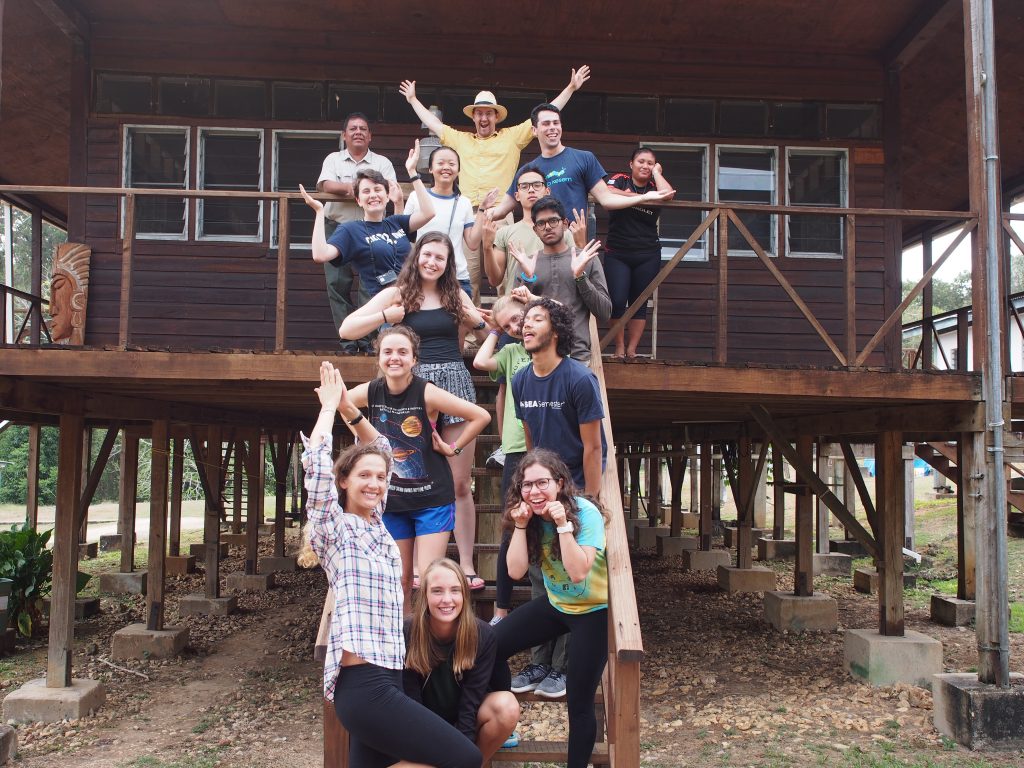
We made two stops on our way: a gift shop called Orange Gallery and a restaurant called Cheers. I bought plenty of Belizean hot sauce to bring home (safe to say I’m hooked), but was kind of disappointed that there weren’t any machetes. As far as lunch goes, I made the most of the $40 Belizean dollar limit we were given, eating three different entrées. Never underestimate the stomach capacity of a small human.
Once we got to the airport, we swiftly made our way through some very lax security. There was wifi at the gate meaning that five days of messages streamed in, which I proceeded to ignore except for the ones from my family and closest friends. I was definitely not ready to reenter reality.
The plane ride was quick and painless, but claiming my bags was quite the opposite. My luggage emerged on the conveyer belt with the zipper broken and articles of clothing tossed about. Thankfully nothing was lost and I made my way to my hotel and then to Target to purchase a new bag.
It’s crazy to think that less than 24 hours ago I was at Las Cuevas and now I’m back in Houston.It’s funny because I feel like I’m going to still have my eyes peeled for ants in my daily life. It feels so odd being at the hotel airport, like it’s some acclimation period between rainforest and city. Although I’m going to miss Belize and the great friends I’ve made on this trip, I’m excited to finally go back home to Miami.
Wrap-up blog
The tropical rainforest and the coral reef are two of the most biologically diverse ecosystems on earth. What similarities exist between these two ecosystems, and how might these similarities relate to high levels of biological diversity? What personal observations have you made about the similarities and differences between these two ecosystems?
We discussed in a lecture once that one of the most interesting similarities between coral reefs and tropical rainforests is that they’re both nutrient-poor, yet they support so many different species. This is all a guess, but I think that might be because low levels of nutrients are a limiting factor that prevents certain species from taking over- for example, when excess nutrients are put into coral reefs, algae tends to dominate and biodiversity decreases. Maybe low nutrient levels give slow-growing organisms like coral and large fauna a chance to mature without too much competition from faster-growing organisms like algae and insects?
Additionally, both coral reefs and tropical rainforests encompass many different physical habitats. Animals in reefs may live in the open water, on sponges, corals, or algae, or under rubble and rock. Likewise, tropical rainforests are stratified into 4 layers, the emergent, canopy, understory and forest floor. These are all different niches that a variety of species can fill.
One difference I noticed is that animals in the rainforest were more fearful of humans than those in the reef. It might have just me? But I was really surprised that while snorkeling around, I could basically swim into a school of fish and they wouldn’t be too alarmed, they would just swim a couple of feet away. Some cleaner fish even came ad nibbled on my hands and flippers! But in the rainforest, it was impossible to see any large fauna like big cats, herbivores, and birds up close. I wonder if that’s because generally large fauna in the rainforest are more intelligent than animals in the reef? I think the most intelligent animal in the reef would be an octopus, and we didn’t see any of those up close (except Squishy), so that would make sense.
How did the course compare with your expectations? What were your favorite—and least favorite—parts of the course? Describe three things that you learned in the course that you consider to be the most important or surprising (i.e., what did you learn that you will remember five years from now)?
I expected, for some reason, much less snorkeling! I think because I was nervous about going into the ocean, I must have blissfully ignored that half of the course going in. But I was happy to have gained experience and confidence in the water over the week we spent at Glover’s; now I’m pretty sure I can put on my dive gear in my sleep. Otherwise, I came with a very open mind, knowing that my idea of the tropics mostly comes from movies and books.
One of my favorite parts of the course was definitely the downtime I had to just explore and look for animals, particularly at Las Cuevas. I loved being able to look down, dig through the leaf litter and find a millipede or something that I’d only seen before at the science museum. Another of my favorite things about this course are the people I was able to meet. It was amazing to hear Scott, Adrienne and Therese talk about their research- I’ve been thinking about doing some kind of ecology research since I was a kid, and I could finally meet a real live ecologist and hear how passionate they are about their work. Also, I loved getting to meet all of the people who helped us during our stay: Javi, Adolfo, Kenneth, Tiffany and Apache to name a few!
My least favorite part of the course was probably the lack of sleep and hygiene. I think that may be all part of doing field research- but I think I much prefer the city life!
With that said, I think after this course I’ve learned that I really do want to stay and work in the city. I’m very passionate about educating the public about the environment and preserving Texas’s native flora/fauna, and I think that working in a foreign country, kind of disconnected from the community isn’t for me. So, being able to experience tropical field research firsthand has somewhat clarified my career goals. (Maybe I’ll create Houston’s first moth zoo?)
Secondly, and though this seems kind of odd, I feel like I’ve learned the power of time management… it was incredible the amount of things we achieved every day in Belize. That was definitely a sharp contrast to my usual summer routine of lazing around on the couch, and I really enjoyed it! So I’m planning to do a lot more with my summer than I usually do, like taking some classes, exploring the city, reading in Fondy (I know how to have fun okay…), trying to sell my drawings??
And finally, one of the biggest things that will stick with me are the people I’ve gotten to know on this trip. I never expected to become part of such a great group of people and I’m excited to poke all of you for years to come!
Don’t Make Me Leave Belize
Today (Day 15) was a loooooong travel day. We woke up early, had one last morning of birding, and got on the bus to head back to Belize City. It was a 5-hour drive, but luckily, we split it up a little.

We drove for a couple hours and then stopped at a souvenir shop called “The Orange Gallery”. It had some very fancy things! I picked out a nice ornament for my mom because she collects Christmas tree ornaments from all the places we visit.
On the second leg of our journey, I started feeling really really carsick. We had to briefly pause for me to throw up in the grass (ew), but I felt much better after that! The second stop we made was for lunch. I really liked this restaurant, and I even got to see one last epiphyte before we left Belize. There was a huge group of Aroids on a tree outside the restaurant.
Our last leg of the trip dropped us off at the airport. Unfortunately we were running a bit late, so we didn’t get to stop to pick up Scott’s gear that he left at Glovers. Check in and security were extremely fast and relaxed, which we all appreciated. Once we got into the airport, we even had wifi! Everyone was very excited.

Thanks to Ellie and Sarah getting searched, we all got to sit together on the plane home. Sarah, Damien, and I finished the crossword in a rapid-fire way (thanks to Sarah’s master crossword skills), and we finally assigned nicknames for everybody.
We said most of our goodbyes at the airport, but a few of us went back to Rice on the bus. We had one last jam session together before it was time to go. Even Turiez joined us and taught us a few songs. I will miss Belize, but I do appreciate the air conditioning and cellular service that comes with being home!
Post-Trip: Reflection
One day in Belize, my class and I noticed a distinct commonality between the two most biodiverse ecosystems – coral reefs and tropical rainforests. Both function in nutrient poor conditions. The two differ greatly in the causations of their low-nutrient conditions. Coral reefs demand low nutrients to hinder algae growth and allow high water clarity, a condition demanded for photosynthetic coral synergists. The trees of the tropical rainforest, however, quickly deplete the soil of nutrients as they grow. While both systems exist in low-nutrient environments, low nutrient levels can lead to coral reef formation while the high nutrient demands of tropical rainforest tree leads to poor soil nutrients.
Regardless, the two ecosystems are able to support such biodiverse systems through their creation of physical spaces. Reefs for nooks and crannies for marine organisms to reside, as well has having great surface areas to accommodate sessile organisms like anemones and sponges. Tropical trees have many layering branches and alcoves within trunks and limbs. Similarly, these create spaces to accommodate more living things. Epiphytes, commensalist plants that grow on taller trees, demand the sunlit canopy trees provide. Structurally, the two have many parallels, which likely explains their comparable biodiversity.
Rainforests and coral reefs both accommodate animals smaller than their open ocean or open grassland counterparts. Not only are these ecosystem’s spaces unable to accommodate larger animals, but also larger animals have the potential to wreak havoc on these systems by overgrazing on or causing mechanical damage to coral or trees.
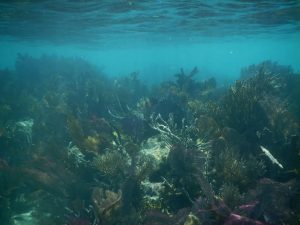
With their elaborate physical structures and densely-packed biodiverse inhabitants, the coral reef and tropical rainforest I visited in Belize filled me with similar senses of awe. There was activity or an interesting organic structure just about everywhere I would look. While I knew in advance that these ecosystems have great biodiversity, there is something about being physically present that makes these facts feel real.
I had very nebulous expectations for this trip. I wanted to learn and to have fun, but other than that, I put very little thought into identifying what I wanted to take away from this trip. This mindset turned out to be a blessing, as I could absorb my surroundings without constantly questioning whether or not my expectations are met. It was freeing to allow myself to be immersed in these beautiful locales and view them for what they are.
My memory of the trip is rich with precious moments – watching a squid jet across a reef, listening to the boisterous conversations of scarlet macaws, seeing the glistening hide of a manatee as it dive back into shallow mangrove waters, feeling the chilliness of the Actun Tunichil Muknal cave, spectating the sunrise over the ocean, viewing the uninhibited star-filled sky, laying on a hammock at the end of a long day. This aggregation of serenity and excitement is what I value most about the trip. While at times I felt stressed about the grade I would make, I strove to keep an empowering mindset that allowed me to fully cherish my surroundings.
The trip left me with a wide range of new knowledge. Ethnographically, Belize has an extremely diverse human population, serving as the home of Mestizos, Creoles, Garifunas, and Mayans to name the most populous. I learned about interesting physical properties of many living, including that mantis shrimp have a grasp so strong they can hurt people, Christmas tree worms always have pairs of polychaetes, conchs’ have two projecting eyes that look like cartoon eyes, and strangling figs can overtake massive canopy-forming trees to form large and extensive woody structures. I also learned about the harmful effect human negligence can have on ecosystems, like lionfish (a nonnative species released from aquariums) overpredate juvenile reef-dwelling fish and the prevalence of Africanized bees in the New World were caused by the escape of seven queens. I’ve learned countless new things that form a mosaic as vibrant and diverse as the colors of Belize itself.
I leave Belize with new memories and knowledge. I will always remember the electric blue of the Caribbean, the stunning vibrancy of scarlet macaw plumage, and the translucence of the Caribbean reef squid. After all, all I have are these memories of Belize until I go back.
Day 15: Goodbye (5/30/2017)
Today began like any other day at Las Cuevas Research Station – with a 6:30 am breakfast. However, today was very different.
Rather than spending the morning in the field, my class and I spent it in a van. We departed from Las Cuevas and are en route to the airport.

Outside my window, I got a glimpse of the tall angiosperm trees that composed the rainforest transition suddenly to the pines characteristic of the mountain pine ridge ecosystem.
Further along, we stopped at a gift shop and a kitschy touristy restaurant. These served as reminders of why I am going to miss Belize so much. Belize is authentic, expressive, passionate, and in touch with reality. These attributes are rarities in the highly commercialize American culture with which I am so familiar.
We arrive at the airport, and I finally said goodbye to Belize, a country that I had had the privilege to explore the past two weeks.
Now I am back home. Like the trees of the rainforest that sharply transitioned into pine, I have to sharply transition from a tropical field biologist to an American college student. After all, I have meetings all day tomorrow and even more work the day after that.
I miss Belize already – the liveliness of the reefs, the vastness of the forest, the inhibition of the night sky, the friendliness of the people.
I know one day I will go back. I’m looking forward to it.
Day 14: Spotlight (5/29/2017)
Three days after setting them up, it was time to retrieve our camera traps. Our morning hike was significantly shorter than Friday’s corresponding hike, taking half as long. A combination of a faster walking pace, increased endurance, and fewer stops to study wildlife accounted for this.
Our afternoon hike was not as seamless, as it took approximately the same amount of time as its earlier counterpart. GPS in hand, I was responsible for leading my class to retrieve one of our camera traps. I faced extreme difficulty in leading, spiraling around the site of the trap, unable to pinpoint its location on the device. My frustration was escalated with the knowledge that twelve other people were watching me and following me through the lignified labyrinth.
After dinner, my class and I analyzed the images from the camera traps. Sometimes our subjects, like the ocelots and the great curassow, bolted from the flash of the camera. Other times, our subjects, like the pacas and peccaries, lingered, unfazed by the flash.
Being the subject of viewership can emote a spectrum of feelings and behaviors. It can drive one to linger to flee or to the edge of insanity.
One set of organisms uninhibited by the spotlight is the scarlet macaws. The macaws made regular appearances around the research site. Today, three of them perched on a Spanish cedar (Cedrela odorata) directly in my class’ line of vision and later moved to a nearby avocado tree (Persea americana). Both of these trees were in an open clearing. The Spanish cedar was large with a pale gray trunk and was primarily leafless. Very little animal activity occurred on this tree, apart from the macaws’ brief visit. The avocado tree had branches that extended laterally and were dense with medium-sized broad leaves.
Deeply saturated with vibrant red, yellow, and blue, the macaws hardly camouflaged with their surroundings. They also call out in cacophonous caws, attracting attention to themselves. These characteristics render scarlet macaws as easy targets of poachers, who sell these majestic creatures into the pet trade.
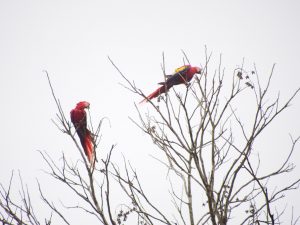
It’s heartbreaking that not only the scarlet macaws but also the ocelots, pacas, and many other animals are subject to poaching – One animal, man, exploiting the beauty or resources of other animals for economic gain. No matter how advanced society becomes, avarice triumphs, for both local poachers and wealthy foreign collectors.
In an undisturbed ecosystem, there is balance. There is predation, parasitism, and competition, but there is balance.
Despite how advanced humans are, there is something we could learn from nature.
Day 13: View (5/28/2017)
Sitting on the station’s porch, I was able to see a crested guan (Penelope purpurascens), a relative of a turkey, perched in a tree. Only the bird’s silhouette was seeable to the naked eye; a spotting scope was needed to see the fire-red jowl and dynamic white and dark spotted pattern on the breast.
My class and I explored the two outermost chambers of Las Cuevas cave. The opening of the cave was enormous, taking up my entire field of vision. The front chamber was decorated with mud and guano from the bats in the ceiling. Light filled the front of the chamber but weakened in a gradient to the back of the chamber. The second chamber was almost completely dark.
Leaving the cave, we encountered an unidentifiable species of snake slithering up about six feet of the cave’s wall and then concealing itself behind a crag. Having such a clear view of the snake and watching it engage in such uncommon behavior was certainly a sight to see.
We later embarked on a hike to Las Cuevas’ bird tower. On the trail, we passed a Brazilian fern tree (Schizolobium parahyba) covered in moss and growing sideways across the path. The higher the elevation we hiked, the more Trumpet trees (Cecropia obtusifolia) we encountered. Trumpet tree leaves were not very dense, but took up quite a bit of space due to their high-surface-area design. The trees shed some of these leaves, which shriveled into gray bundles on the ground.
Upon reaching the top of a large hill, we climbed to the top of the bird tower to be rewarded with an unparalleled view of the forest. From this elevated vantage point, you could see rolling hills abundant with green, gently integrating into the mist in the distance. The sky was a sharp shade of blue, and the color grew sharper and warmer as the sun set. The clouds were backlit, appearing a warm golden color. Time passed, and the sky grew warmer and warmer but then effortless transitioned to a cool indigo when the sun hid behind the horizon.
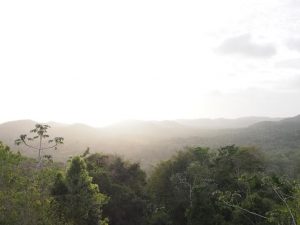
We walked back from the sight in the dark of night. Only the contents of glowing projections from our headlamps were visible. The views were restricted but still allowed us to encounter the scorpions, spiders, crickets, and cockroaches that emerge only in the darkness.
From the magnified view from the spotting scope to the partially-illuminated view within the cave to the all-seeing view from the bird tower to the insular view of the headlamp’s contents, today’s views were as diverse as the rainforest’s wildlife itself. Diversifying not only what I see but also how I see it has allowed me to gain appreciation for the rich content of the rainforest, at all different scales.
I feel much closer to seeing the whole picture.
Day 12: Social Interactions (5/27/2017)
I wake up in the middle of the night and step outside to something I have never felt before. It is the rainforest night. The air is rich with animal sounds. The sky is pitch black but adorned with countless stars, creating the illusion of a deep indigo-gray. Heartbeats of lighting illuminate the sky, but there is no rain. An unmatched sense of awe comes over me, something I could only feel being alone before nature’s grandeur.
Many hours later, my class and I are in the forest. Tall kapok trees (Ceiba pentandra) along the path form islets of intense shade, and yellow prickly trees (Zanthozylum spp.) sporadically flank the path with yellow-brown adornments. Some of the yellow prickly plants were speckled with tiny crawling ants. These leaf-cutter ants chisel and delivery circular sheets of leafs to their colonies, advanced eusocial communities that mature over time.
We say three ant colonies: one year old, four years old, and ten years old. Similar to an individual organism, the colonies aged, growing larger and more advanced with time. Leaf-cutter ants sustain by cultivating fungus on leaf pieces concealed in underground chambers, and thus colonies must have increasing number of chambers to grow enough food to feed their growing numbers. With time, colonies supported more types of workers and had longer, deeper, and wider tunnels.
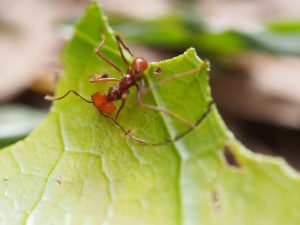
Late in the afternoon, I saw five scarlet macaws (Ara macao) fly across the sky in unison. Although macaws lack a complex social structure like leaf-cutter ants, they still cluster for social interaction and increased protection from predators.
It is interesting how human social interactions relate to those of other organisms. Some people have clearly defined senses of duty, like worker ants chiseling leaves for their colonies. Some exhibit altruism, like a scarlet macaw rearing her chicks. Even if there is no evolutionary relationship between the social interactions of humans and other animals, it is interesting to see the common elements.
However, sometimes it’s preferred to forgo my social role and be alone. The sky is much more powerful that way.
